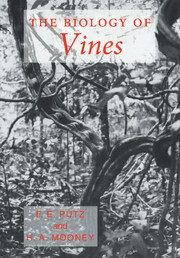Book contents
- Frontmatter
- Contents
- List of contributors
- Foreword
- Preface
- Acknowledgements
- I INTRODUCTION
- II CLIMBING MECHANICS AND STEM FORM
- III VINE PHYSIOLOGY AND DEVELOPMENT
- IV COMMUNITY ECOLOGY OF VINES
- 11 Distribution and abundance of vines in forest communities
- 12 Vines in arid and semi-arid ecosystems
- 13 Vine–host interactions
- 14 Seasonality of climbers: a review and example from Costa Rican dry forest
- 15 Breeding and dispersal systems of lianas
- V ECONOMIC IMPORTANCE OF VINES
- Taxonomic index
- General index
11 - Distribution and abundance of vines in forest communities
Published online by Cambridge University Press: 05 November 2011
- Frontmatter
- Contents
- List of contributors
- Foreword
- Preface
- Acknowledgements
- I INTRODUCTION
- II CLIMBING MECHANICS AND STEM FORM
- III VINE PHYSIOLOGY AND DEVELOPMENT
- IV COMMUNITY ECOLOGY OF VINES
- 11 Distribution and abundance of vines in forest communities
- 12 Vines in arid and semi-arid ecosystems
- 13 Vine–host interactions
- 14 Seasonality of climbers: a review and example from Costa Rican dry forest
- 15 Breeding and dispersal systems of lianas
- V ECONOMIC IMPORTANCE OF VINES
- Taxonomic index
- General index
Summary
Introduction
Where species diversity of vines is high, usually relative abundance is also high. However, because of their thin stems vines seldom form more than a minor proportion of the biomass of any forest, even in the tropics. Exceptions to this rule are often found during regeneration of very disturbed sites, where one or two species of vine become dominant. This chapter reviews the results of various quantitative studies of vines, mostly from mature tropical and subtropical forests.
As used in this chapter, ‘vines’ include all non-epiphytic climbers and, unless otherwise noted, those which commence life in the soil but may later become epiphytic, i.e. secondary hemiepiphytes. The vines therefore include the predominantly herbaceous, leafy smaller climbers and the mostly woody, bare-stemmed larger lianas (or lianes), between which there are loosely defined distinctions depending on regional usage.
The contribution of vines to forest structure in various regions
Abundance
Comparisons of the abundance of the thicker-stemmed vines (i.e. those greater than 2.5 cm in diameter) in forests of various regions have been made by Gentry (Chapter 1). However, as shown in studies such as those of Rollet (1969a, b), Proctor et al. (1983), Putz (1984) and Hegarty (1988), high proportions of stems of vines are found in the smaller size diameter-classes. Thin vines make an appreciable contribution to species richness (Gentry & Dodson, 1987).
- Type
- Chapter
- Information
- The Biology of Vines , pp. 313 - 336Publisher: Cambridge University PressPrint publication year: 1992
- 17
- Cited by



